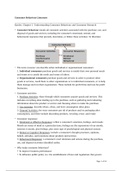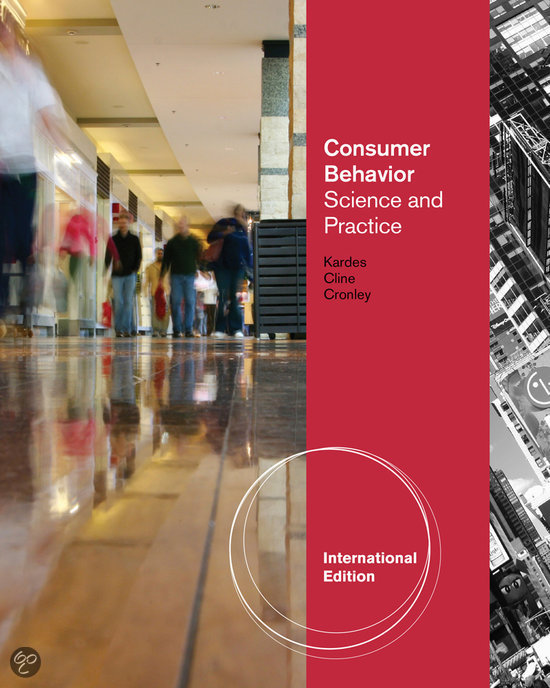Consumer Behaviour Literature
Kardes: Chapter 1. Understanding Consumer Behaviour and Consumer Research
- Consumer behaviour entails all consumer activities associated with the purchase, use, and
disposal of goods and services, including the consumer's emotional, mental, and
behavioural responses that precede, determine, or follow these activities. To illustrate:
- The term consumer can describe either individual or organisational consumers:
1. Individual consumers purchase goods and services to satisfy their own personal needs
and wants or to satisfy the needs and wants of others.
2. Organizational consumers purchase goods and services in order to produce other
goods or services, resell them to other organisations or to individual consumers, or to help
them manage and run their organization. These include for-profit firms and non-for-profit
businesses.
- Consumer activities:
1. Purchase Activities: those through which consumers acquire goods and services. This
includes everything done leading up to the purchase, such as gathering and evaluating
information about the product or service and choosing where to make the purchase.
2. Use Activities: describe where, when, and how consumption takes place.
3. Disposal Activities: the ways consumers get rid of products and/or packaging after
consumption, and these include discarding products, recycling, reuse, and resale.
- Consumer responses:
1. Emotional or Affective Responses: reflect a consumer's emotions, feelings, and moods.
Moods are states of mind at a particular time; feelings are the expressions of our moods;
emotion is moods, plus feelings, plus some type of psychological and physical arousal.
2. Mental or Cognitive Responses: include a consumer's thought processes, opinions,
beliefs, attitudes, and intentions about products and services.
3. Behavioural Responses: a consumer's overt decisions and actions during the purchase,
use, and disposal activities identified earlier.
- Why study consumer behaviour?
• To improve business performance
• To influence public policy (i.e. the establishment of laws and regulations that govern
Page 1 of 54
, business practices in order to protect consumers - e.g. nutrition food panels are the result
of consumer behaviour research related to public policy)
• To educate and help consumers make better decisions
- The marketing concept is the idea that firms should discover and satisfy customer needs
and wants in an efficient and profitable manner, while benefiting the long-term interests of
the company's stakeholders.
- The marketing concept is a core philosophy for many organisations. As a result, these
successful organisations focus on delivering customer perceived value and customer
delight.
- Customer perceived value is the consumer's overall assessment of the utility of a product
based on perceptions of what is received and what is given.
- Customer delight is surprising a customer by exceeding his or her expectations and thus
creating a positive emotional reaction.
- There are three prominent approaches in consumer behaviour research:
1. Motivation Research: assumes the existence of underlying or unconscious motives that
influence consumer behaviour. Here, in-depth interviewing techniques are used to uncover
a person's hidden or unconscious motivations. Hence, a focus on consumer motivations
using the technique of in-depth interviewing.
2. Behavioural Science: behavioural scientists study people and their behaviours in the
same way that natural scientists study physical phenomena. The primary methods of
behavioural science include the experimental approach - conducting controlled
experiments - and the marketing science approach - employing computer-based
simulations. Hence, quantitative research methods are primarily used (where, empirical
data is collected), along with the scientific method (i.e. a collection of systematic activities
that enables researchers to study problems and find answers to questions). The steps of the
scientific method include:
• Observe and ask the question
• Form a hypothesis and make a prediction
• Test the hypothesis
• Theory prediction
3. Interpretivism: scientists view consumers as non-rational beings where their reality is
highly subjective. Researchers' goal is to collect data to describe and interpret this reality.
Here, qualitative research methods are employed entailing descriptive, non-empirical data
that describe an individual consumer's subjective experience with the product or service.
- Consumer insight is a deep, profound knowledge of the consumer that comes from
integrating traditional marketing research tools with consumer behaviour theories. These
insights can structure a company's thinking and decision making.
Page 2 of 54
,- Marketing research is a systematic process of planning, collecting, analysing, and
interpreting data and information relevant to marketing problems and consumer
behaviour. It enables businesses to better understand the market(s) in which they compete
and the broader environment in order to identify opportunities and threats.
- Effective marketing and consumer research provides marketers with relevant information
for making decisions, reducing uncertainty, improving profits, and developing consumer
insights.
- Consumer research is divided into two broad categories based on the goals of the research:
1. Basic Research looks for general relationships between variables, regardless of the
specific situations. Conclusions drawn from it generally apply across a variety of situations,
and researchers can use these generalisations to guide strategic planning and develop
marketing tactics. Basic research variables studied can include those related to the
consumer, such as personality or demographic variables; they can also relate to the
marketing mix (product, price, place, and promotion).
2. Applied Research examines many of the same variables as basic research, but within a
specific context of interest to a marketer. It is more common than basic research because
consumer researchers want to solve particular business-related problems of immediate
interest.
- The steps of the marketing research process include:
1. Define the problem or opportunity
2. Determine the research design
3. Design data collection method and forms (primary data or secondary data?)
4. Sampling and data collection
5. Analysis and interpretation of results
6. Recommendations
- Part of the research process is determining the research design. There are three main types
of research design:
•Exploratory Research is broad, qualitative research done to generate ideas or help
further formulate problems for further research. This type of research is often done when
little is known about the problem or research issue. Qualitative primary data collection
methods include:
1. Focus Groups - consists of 8 to 12 participants run by a moderator who monitors and
guides the group discussion of the research topic at hand.
2. In-depth Interview - a one-on-one interview lasting at least one hour.
3. Projective Techniques - unstructured, indirect form of questioning that encourage
respondents to project their underlying beliefs, attitudes, feelings, and motivations in an
apparently unrelated or ambiguous scenario. These consists of a variety of tests that fall
under four broad categories: word-association tests, completion tests, construction tests,
and expression tests.
Page 3 of 54
, 4. Observation - allow researchers to record people's behaviour, either with or without their
knowledge.
•Descriptive Research is done to describe the characteristics of some group or their
behaviours, or to make predictions about trends or variables. Data related to descriptive
research designs are collected with two types of studies:
1. Longitudinal Studies - data that are collected at various points in time, over time.
2. Cross-Sectional Studies - examine one variable in different groups that are similar in all
other characteristics.
•Causal Research is concerned with identifying and understanding cause-and-effect
relationships through experimentation. Consumer researchers are especially interested in
uncovering two special types of relationships - correlations and causal. When a statistically
testable and significant relationship exists between two variables, we say the variables are
correlated. A causal relationship between two variables means that the variables are
correlated and that one variable influences the other, but not the vice versa. Causal
research is conducted using experiments (i.e. manipulate variables in a controlled setting
to determine their relationship to one another). There are three types of variables:
1. Independent Variables - what changes.
2. Dependent Variables - what you measure.
3. Constants - what stays the same.
- There are two broad sources of data:
1. Primary Data: new data collected for the research purpose at hand.
2. Secondary Data: data that already exist and are readily accessible.
Kardes: Chapter 9. The Consumer Decision Making Process
- Consumer decision making can be defined by the amount of effort people exert to solve a
problem.
• Routine Choice is carried out automatically, with little conscious effort. As such, it
involves no information search or deliberation.
• Intermediate Problem Solving usually involves limited information search and
deliberation. Simple decision rules aid decision making.
• Extensive Problem Solving requires a deliberate and systematic effort. Consumers
engage in extensive problem solving for infrequently purchased, expensive products.
- Consumer decision making can be characterised as a joint function of processing effort and
involvement:
1. Processing Effort represents a continuum from automatic to systematic processing.
2. Involvement represents a continuum ranging from decisions that entail low levels of
consumer involvement or personal relevance to decisions that elicit much higher levels of
interest and concern. It is the personal relevance or importance of an issue or situation. If a
Page 4 of 54





